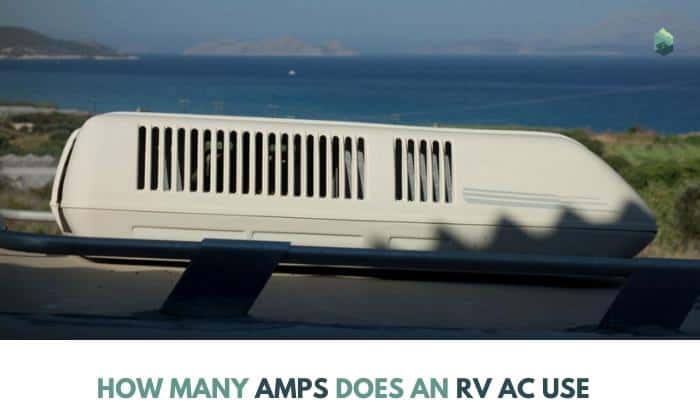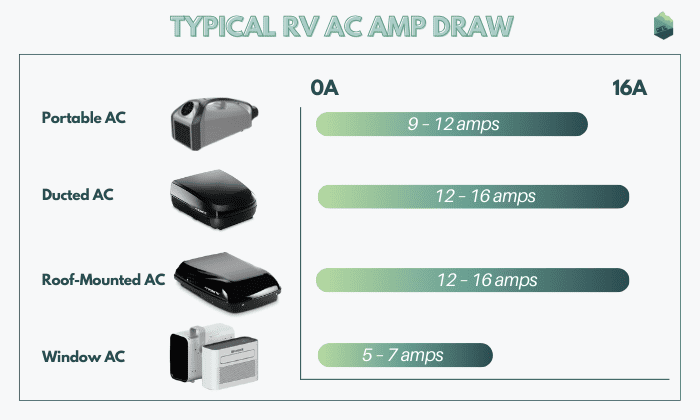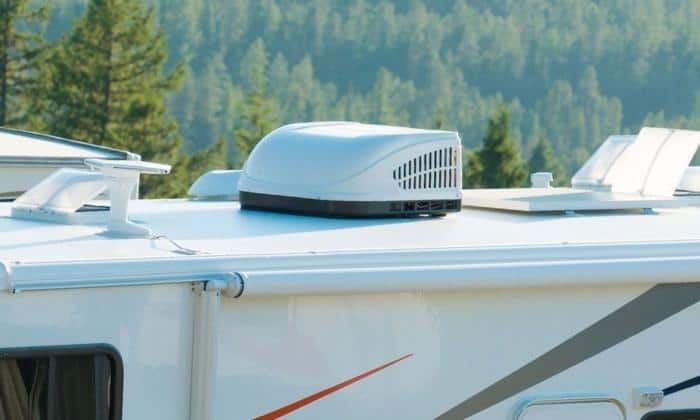An RV air conditioner draws an average of 5 to 16 amps, depending on factors like condition and cooling capacity.
Air conditioning is a must-have feature in many RVs, especially during the sweltering summer months. It can be your savior from the heat, ensuring a comfortable time on the road or on the ground. You can sleep better and feel at home, even with a high outside temperature.
Operating the AC, however, requires a thorough understanding of how it works. Many people are curious – how many amps does an RV AC use? Keep on reading to know more. With the right knowledge, you can be confident of matching electricity supply to your needs.
Before we proceed, here’s a quick current draw chart to give you a glimpse of the amperage that different types of RV are using.
| TYPE OF AC | AMP DRAW |
| Portable AC | 9 – 12 amps |
| Ducted AC | 12 – 16 amps |
| Roof-Mounted AC | 12 – 16 amps |
| Window AC | 5 – 7 amps |
Page Contents
Typical RV AC Amp Draw
The type of an RV AC impacts its functionality and also the amp draw. Here’s a quick glimpse at the different AC types suitable for an RV:
1. Portable AC
With its small size and low cooling capacity, it is expected that portable AC will have a low amp draw. On average, it will use only 9 to 12 amps.
2. Ducted AC
Equipped with a complex ducting system that ensures proper cool air distribution, it has an average amp draw of 12 to 16 amps.
3. Roof-Mounted AC
This is the most popular among the different types of RV ACs. The RV rooftop AC and heat unit draws 12 to 16 amps on average, similar to its ducted counterpart.
4. Window AC
It’s quite uncommon to find this in an RV. If you opt for one, note that it has approximately 5 to 7 amps.
Factors Affecting Current Requirement
Different factors affect the amp draw of an RV air conditioner, including the following:
- Condition of the AC: Newer RV ACs are popular for packing innovative features. These technologies can make the AC more energy-efficient. Hence, they usually have a lower amp draw.
- Cooling Capacity: The larger an RV, the more amperage it will draw. Hence, if you want something more efficient in power consumption, opt for smaller units, but make sure it is appropriate for the size of your RV.
- External Conditions: Is it extremely hot outside the RV? The outside temperature is another factor to consider.
- Internal Temperature: A lower temperature requires more effort to cool your RV interior, increasing the amperage.
- Insulation: When well-insulated, your RV can retain a cool temperature. Hence, it also makes the amp draw lower.
Can I Run RV AC on 30-amp Outlets?
Yes, an RV AC will run on a 30-amp outlet. However, different problems could be apparent, which can impact the functionality of the AC.
One of the biggest problems is power limitation. It may not power the cooling system for a long time. The system may experience overloading.
More so, the AC may not end up cooling your RV interior. This can make you uncomfortable, especially when the heat outside is intense.
To prevent overloading, consider upgrading to a more energy-efficient RV AC. Keeping the unit clean will also help. Plus, you’ll benefit from improving insulation and parking in a shaded area.
Moreover, you can swiftly determine the amperage utilizing the tool below.
Or, the simple formula for calculating the amperage is:
A = W / V
A = the amperage
W = the wattage of the AC
V = the voltage, which is typically 120 in the United States.
Conclusion
In this article, we talked about how many amps does an RV AC use. As noted, it depends, such as based on the type of AC that you have. Generally speaking, however, it can be anywhere from 5 to 16 amps. Newer models tend to be more energy-efficient, which also allows them to draw lower amps.

My career journey has been marked by a variety of roles. I served as a Personal Trainer for Children, Fitness Instructor, and Home-Based Consultant in Detroit Wayne Integrated Health Network.
More than ten years of traveling in my caravan have lent me a deep appreciation of freedom. Without the shackles of being tied down to one place, I get to explore many parts of the world and relish the exhilaration that comes with discovering new things. Throughout my journey, I have been a member of FMCA (Family Motor Coach Association) since 2020. Thus, living on the road has never become boring for me.
As someone with a burning passion for traveling, I want to inspire others to adopt a nomad lifestyle to appreciate the beauty of the world. This, of course, requires a functioning vehicle that can always make you feel at home, even when you’re far away from modern life.
Therefore, I seek to put my experience to good use—helping you with your adventure on the road. As a result, I launched and managed the Outdoorbits website, where I likely share my enthusiasm for outdoor activities and health-related insights.


